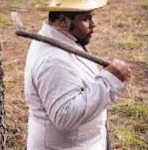This article is by (Guest Blogger) Culinary Historian Michael Twitty of Afrofoodways. I met him a few years ago at the Smithsonian Folklife Festival, where he had an exhibit. I have been bugging him to write an article for a couple of years now. I expected a recipe with background story that tied his African American culture with his (adopted) Jewish faith..which this is not. It’s a helluva read. Thanks Michael.
-JAY
—————————–
 I am not big on Thanksgiving. I can’t stand the set menu. It doesn’t mean much to me. Sure, I love a brined breast or fried turkey leg as much as the next nouveau gourmet addicted to food porn and Paula Deen; but its okay—nothing special. Besides, according to my adopted faith I’m supposed to eat a button-bursting meal the next day for the Sabbath. Commercials with disgusting green bean casserole with those canned onion ring things sucked up by thuggin’ evergreens that take a bite and go all a flutter with Christmas queer? Cranberry sauce from a can? Really? Cranberries hand-picked by Martha Stewart with a friggin’ 19th century cran-cradle and lovingly stewed into something that looks like the insides of road kill? Goyishe naches!
I am not big on Thanksgiving. I can’t stand the set menu. It doesn’t mean much to me. Sure, I love a brined breast or fried turkey leg as much as the next nouveau gourmet addicted to food porn and Paula Deen; but its okay—nothing special. Besides, according to my adopted faith I’m supposed to eat a button-bursting meal the next day for the Sabbath. Commercials with disgusting green bean casserole with those canned onion ring things sucked up by thuggin’ evergreens that take a bite and go all a flutter with Christmas queer? Cranberry sauce from a can? Really? Cranberries hand-picked by Martha Stewart with a friggin’ 19th century cran-cradle and lovingly stewed into something that looks like the insides of road kill? Goyishe naches!
I am not snarky. I’m actually the kind of metaphysical-spiritual-earthy-wispy food fairy that makes Anthony Bourdain want to go postal. I am just annoyed that good food in American culture is symbolized by a meal the Pilgrims didn’t even eat. It’s a holiday built on food fakelore and myths meant to re-connect North with South, immigrant with native, and 19th century Manifest Destiny with 17th century Gold, God and Glory. During the one pleasant memory I have of the holiday—the Macy’s Thanksgiving Day Parade–my militant high-yellow grandmother used to remind me every year, “See them marching down Fifth Avenue; the Dutch ripped the Indians off for 24 bucks! Shame! Shame! The Indians should have put glass in the Pilgrim’s food—would have saved them some trouble!” Grandma was multicultural when multicultural wasn’t cool. Ripe with symbolism and cultural myths that have nothing to do with me and my people(s); and a menu that makes me want to regurgitate, I never liked Thanksgiving. Maybe it never liked me.
But I guess I’m Frank Capra enough to admit that Thanksgiving isn’t about the idol of Norman Rockwell’s images of tables of plenty. It’s about the family and the friends and the connections between each other. If you have a house to go to, and a table to sit around and food on the table to eat—you give thanks. Thanks to God or the animals and plants that gave it up, or Mom for making it, or each other for being there, or gratitude for making it in traffic. This isn’t about me and my cultural angst towards the blanket mandated closing of America and the earliest retail day of the year that follows it. This is about being thankful and all that this means to us.
It’s been a hard year. I have to admit I’m poor like never before thanks to Ms. Recession. It sucks for most of us out here. And yet I feel more connected to the past I study—the world of enslaved men and women—and their sharecropper kids. I’m thankful that I have a precedent to rely on. Stories of “wishmeat” sandwiches and great-grandparents who drank eight glasses of water while eight hungry kids sat around a table devouring a pot of beans with cornbread down to the last drop and crumb. Without those weekly fasts, I might not be here. I am thankful for a system of survival meant for times like these.
This year I was fortunate to curate and cultivate a 19th century kitchen garden at the Montgomery County Historical Society. I’m grateful for the sixty-one different types of plants we grew there…many of which I got to taste and cook. Collards and cabbages, carrots, parsnips, salsify, celery, parsley, lettuce, potatoes, onions, turnips and turnip greens, okra, heirloom tomatoes, peppers hot and sweet, sweet potatoes, corn, pattypan squash, green beans, lima beans, black eyed and other field peas, peanuts, nasturtiums, pumpkins, muskmelons, basil, oregano, marjoram, sage, mint, thyme, rosemary came from the giving earth. Each sprout, each flowering, each fruiting made my hand tremble. I was partner with the earth and not its enemy to make my food come alive. Green glaze collards sliced up with red onions and streaked fish peppers and garlic and olive oil and chicken stock over Carolina Gold rice plated with edible nasturtiums in reddish orange, pinkish yellow and sunburst amber blossoms. Wow! Thanks, isn’t the word. Reverence comes closer.
I’m thankful that my Mother is still here to teach me what real food should taste like and the secrets of our brand of Southern cooking—courtesy of southern Ohio by way of Alabama by way of Virginia and the Carolinas by way of Africa, England and the villages of my Creek ancestors. I chatted her up about shelling bags of crowder peas on the stoop, footlong (“Were they really?) Kentucky Wonder beans, about men selling sugarcane and watermelons from the backs of trucks, grilling pork chops over hot charcoal and chicken wire; and tea cakes—a fluffy Southern adaptation of English tea biscuits that every Black woman in my grandmother’s generation had a recipe for. I’m thankful she still tests me—how does a fresh potato roll keep from getting soggy? How do you know skirt steak gravy is ready to come together? How do you clean a collard properly?
I give thanks for being able to give back. It’s giving kids just learning the joy of growing their own food, heirloom seeds and lessons in Black food history at the Washington Youth Garden. It’s being aware that a homeless person took a couple of healthy bites from the corners of the historical garden. It’s hands of bananas and cans of tuna to the men and women who advertise their hunger on Rockville Pike. Thankfulness is taking my 91 year old Grandfather from South Carolina to the Obama inauguration and stuffing him with fried chicken and in his words, “a hot samm’ich” after walking him back “a country mile” to the Imani temple where his van was docked. Being thankful is appreciating being able to have places to write for.
-Michael Twitty


